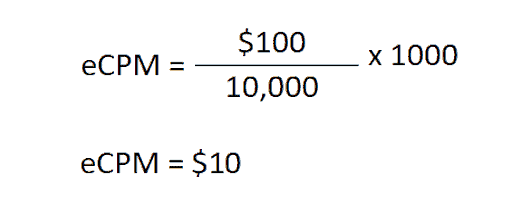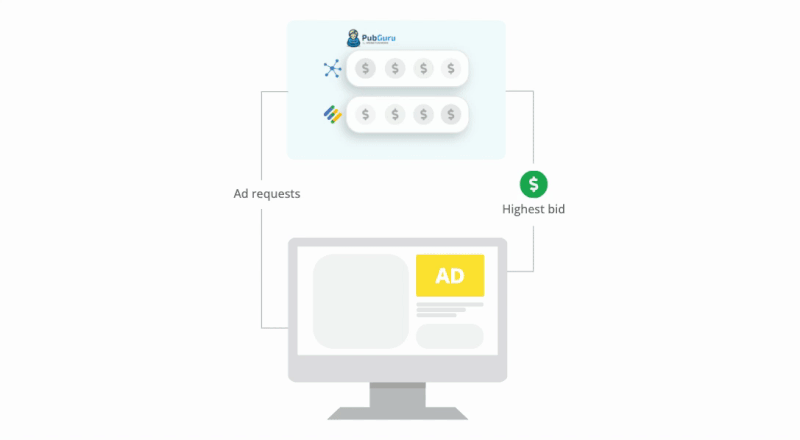Maximizing ad revenue is a top priority for publishers, but with so many different metrics to track, it can be easy to get confused. Two of the most commonly used metrics in the industry are CPM and eCPM, but while they may sound similar, they have distinct differences that are important to understand. In this post, we’ll explore the differences between CPM and eCPM, how to calculate each, and how they can be used to measure earnings.
By the end of this post, you’ll better understand these important metrics and how to use them to optimize your ad monetization strategy.
CPM
Let’ start first with CPM. CPM stands for “Cost Per Mile” or cost per 1000 impressions. Advertisers set their desired price per 1000 ads served.
For example, the advertiser budget for a campaign is $20, and the ad receives 2000 impressions. To calculate CPM you take ($20/2000) * 1000 = $10 which means that the advertiser is willing to spend $10 for every thousand impressions.
CPM = (Cost of the campaign/ Number of total impressions) * 1000


The CPM rate helps advertisers and companies to spread their products to a larger audience for an effective advertising cost.
It is also a great metric used by advertisers to measure the cost of the campaign, how much the publisher will get paid for every 1,000 impressions, and to evaluate the effectiveness of displaying ads.
CPM is traffic driven, the higher the traffic of the site the better the CPM.
eCPM
eCPM or “Effective Cost per thousand impressions” is used by publishers to determine the revenue generated from a thousand impressions of an ad campaign and to measure the performance of a publisher’s inventory being sold in various channels.
For example, if an ad campaign generated $100 revenue after receiving 10,000 impressions, the eCPM would be ($100/10,000) * 1000 = $1. This means that the publisher can earn $1 per 1000 impressions.
eCPM = (Estimated Earnings / Number of total impressions) * 1000


When is eCPM useful for publishers?
- When running a direct-response campaign
- To compare site performance to averages
- A universal standard of measurement regarding revenue for the impression sold.
- Can be used as a critical indicator of the campaign’s performance.
- Allows publishers to optimize their revenue better.
- Can apply to any other buying method such as CPA, CPC, etc.
When is CPM useful for publishers?
- Visitors don’t need to click on the ads for the publisher to earn ad revenue.
- Can be placed anywhere on the site easily.
- A publisher can determine the expected revenue per impressions.
- There’s no concern regarding CTR.
- Allows publishers to generate revenue based on traffic.
- It’s served for a fixed price and can be a predictable revenue stream.
Real-world examples (CPM vs. eCPM)
Example 1: A publisher has two ad units on their website with the same CPM, but one has a higher eCPM due to higher click-through rates (CTR). The publisher can use this data to optimize their website layout to improve CTR and increase eCPM.
Example 2: A publisher has two different ad networks with the same CPM but different eCPM due to varying levels of targeting and relevancy. The publisher can use this information to choose the better-performing network to increase revenue.
Example 3: A publisher wants to optimize their ad stack for maximum revenue, so they use both CPM and eCPM to determine which ad units and networks perform best.
Impact on revenue (CPM vs. eCPM)
- Higher eCPM means higher revenue per impression, so optimizing for eCPM can lead to increased overall revenue.
- By focusing on eCPM instead of just CPM, publishers can ensure they deliver more valuable impressions to advertisers and thus receive more revenue per impression.
- Tracking eCPM over time can help publishers identify trends in their ad performance and make changes to improve revenue over the long term.
Future trends (CPM vs. eCPM)
- Viewability is becoming increasingly important in the advertising industry, so eCPM calculations may need to take viewability metrics into account in the future.
- The rise of new ad formats like native ads and programmatic audio could impact the way CPM and eCPM are calculated and compared.
- As privacy regulations like GDPR and CCPA evolve, ad targeting and relevancy may become more challenging, potentially impacting eCPM calculations.
- Advances in machine learning and AI could lead to more sophisticated eCPM calculations that consider a wider range of data points, allowing publishers to optimize their ad performance better.
Conclusion

In Summary, CPM is the rate that the advertiser is willing to pay for a 1000 impressions and eCPM is the earning of the publisher per 1000 impressions.
We use CPM to increase visibility, advertise for relevant audiences, and drive high-performing campaigns. eCPM is very helpful for publishers to evaluate and optimize their monetization by monitoring ad revenue generated from campaigns.
It is important that publishers and advertisers know the difference so that publishers can accurately measure the revenue performance and the campaign costs for better forecasting. Are you ready to maximize your ad earnings? Sign up for a Starter account at MonetizeMore today!
FAQ
What is the difference between CPM and eCPM?
CPM is the rate that advertisers pay per 1000 impressions. eCPM is the ad revenue of a publisher per 1000 impressions. Find out more about CPM and eCPM in our blog post.
How do you calculate eCPM?
eCPM = (Estimated Earnings / Number of total impressions) * 1000
What is the difference between CPM and RPM?
CPM is the rate advertisers pay per 1000 impressions for ads. RPM is the ad revenue a publisher earns per 1000 impressions on their website. RPM can also be calculated on an ad, session, or page basis.
source https://www.monetizemore.com/blog/cpm-vs-ecpm/


0 Comments